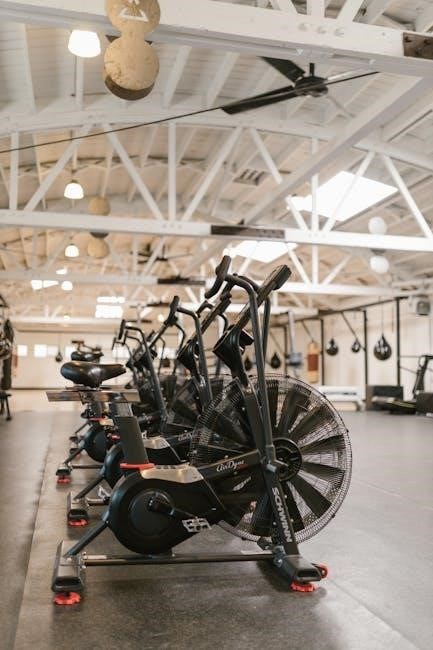800m training requires a balanced approach, combining endurance, speed, and technique. A well-structured schedule ensures athletes build stamina, explosive power, and race strategy. Consistency, nutrition, and recovery are key.
1.1 Overview of the 800m Event
The 800m is a middle-distance race requiring a blend of endurance, speed, and tactical awareness. Athletes must balance aerobic capacity with anaerobic power, making it one of the most demanding track events. The race typically consists of two laps on a standard track, with athletes starting in designated lanes. Proper pacing is critical, as runners need to conserve energy while positioning themselves strategically. The 800m demands a well-rounded athlete, capable of sustaining speed over distance while executing precise race tactics to outperform competitors.
1.2 Importance of a Structured Training Schedule
A structured training schedule is essential for 800m athletes to build endurance, speed, and race-specific skills. It ensures progressive overload, preventing plateaus and injuries. A well-planned schedule balances intense workouts with recovery, fostering long-term improvement. Consistency is key, as erratic training leads to mental and physical fatigue. Periodization helps peak performance at the right time. Customizing plans for individual needs maximizes results. A structured approach also reduces anxiety, providing clarity and focus. This systematic method ensures athletes are prepared for race demands, making it a cornerstone of successful 800m training.

Key Components of 800m Training
Endurance, speed, strength, technique, and flexibility form the core of 800m training. Each component builds foundational fitness and race-specific skills for peak performance and durability.
2.1 Endurance Training
Endurance training is the backbone of 800m preparation, enhancing cardiovascular capacity and muscular stamina. It involves long runs, tempo sessions, and high-mileage weeks to build aerobic efficiency. Coaches often incorporate interval workouts and threshold runs to boost lactate threshold, allowing athletes to sustain faster paces. Consistency is key, as gradual progression prevents injury and improves performance. Proper pacing and recovery are emphasized to ensure athletes adapt effectively. Over time, this foundation enables runners to maintain speed and composure during races, making endurance training an essential component of a successful 800m strategy.
2.2 Speed and Sprint Training
Speed and sprint training are critical for 800m athletes to develop explosive power and acceleration. Short, intense intervals like 200m and 400m repeats at maximum effort improve neuromuscular coordination and anaerobic capacity. Hill sprints and resistance training also enhance leg strength and speed endurance, crucial for maintaining velocity in the final stages of the race. These workouts should be balanced with recovery to prevent overtraining. Incorporating speed drills ensures athletes can maintain form and composure at high intensities, making them more competitive in race scenarios.
2.3 Strength and Conditioning
Strength and conditioning are vital for 800m athletes to enhance power, stability, and resilience. Weightlifting exercises like squats, lunges, and deadlifts improve leg strength and core stability, reducing injury risk. Plyometric drills, such as box jumps, boost explosive power for faster starts and finishes. Resistance band work and bodyweight exercises like push-ups and planks strengthen upper body and core muscles, enhancing overall athleticism. Incorporating strength training into the schedule ensures athletes maintain proper form under fatigue, delivering more efficient and powerful strides during races. A well-rounded conditioning program complements endurance and speed work, creating a balanced and robust athlete.
2.4 Technique and Form
Proper technique and form are essential for optimal performance in the 800m event. Maintaining good posture, midfoot striking, and relaxed shoulders reduces injury risk and enhances efficiency. Drills like high knees and butt kicks improve stride mechanics. Focused breathing and arm placement also play a role in maintaining rhythm. Athletes should practice sprinting with proper form to ensure they can maintain technique under fatigue. Incorporating form-focused workouts into the training schedule helps build consistency and confidence. Over time, good form becomes second nature, allowing athletes to conserve energy and deliver a strong finish in races.

2.5 Flexibility and Mobility
Flexibility and mobility are crucial for 800m athletes to maintain efficient movement and prevent injuries. Incorporating dynamic stretches, such as leg swings and lunges, improves range of motion. Static stretches for hamstrings, hip flexors, and calves should follow workouts. Mobility exercises like glute bridges and hip circles enhance joint health. Foam rolling and massage guns can aid muscle recovery. Prioritizing flexibility ensures better stride mechanics and reduces muscle tension. Regular stretching routines, ideally 3-4 times a week, complement strength training and endurance work. Over time, improved flexibility enhances performance and supports long-term durability for demanding 800m races.
Sample 800m Training Schedules
Structured training plans for 800m include beginner, intermediate, and advanced levels. Each schedule incorporates endurance runs, speed workouts, and recovery sessions to build stamina and explosive power progressively.
3.1 Beginner Training Schedule
A beginner’s 800m training schedule focuses on building foundational endurance and speed. Start with three runs per week: one shorter run, one longer run for stamina, and one interval session. Incorporate proper warm-ups and cool-downs to prevent injuries. Strength training once a week can enhance overall performance. Gradually increase intensity and volume over time to avoid burnout. Consistency and patience are key to improving race performance and building a strong base for more advanced training in the future. Recovery days are crucial to allow the body to adapt and strengthen.
3.2 Intermediate Training Schedule
An intermediate 800m training schedule builds on foundational fitness with increased intensity and variety; Aim for five structured sessions per week, including endurance runs, speed workouts, and strength training. Incorporate interval sessions like 4x400m at race pace and tempo runs to improve lactate threshold. Include hill sprints for explosive power and longer runs for stamina. Periodization is key, with phases focusing on strength, speed, and race-specific preparation. Ensure proper warm-ups, cool-downs, and nutrition to support performance. Balance running with cross-training to avoid overtraining. Rest and recovery days are essential for adaptation and progress. This schedule bridges the gap between foundational fitness and advanced competition readiness.
3.3 Advanced Training Schedule
An advanced 800m training schedule is tailored for experienced athletes aiming to optimize performance. It includes high-intensity interval training, such as 600m repeats at faster-than-race pace, and pro/anti-day workouts to refine race strategy. Strength training focuses on power and explosiveness, with plyometrics and resistance exercises. Periodization is crucial, with phases like speed development, lactate threshold improvement, and race-specific preparation. Incorporate tempo runs and hill sprints for endurance and speed. Recovery is prioritized with active techniques like massage and ice baths. Nutrition is personalized to fuel intense sessions and aid recovery. This schedule demands discipline and precision to achieve peak performance at competition time.

Periodization of Training
Periodization divides the training year into phases, focusing on building endurance, strength, and speed. It ensures progressive overload and recovery, peaking for key competitions effectively.
4.1 Annual Training Plan
An annual training plan for 800m runners typically spans 52 weeks, divided into specific phases: base building, strength, speed, and race preparation. Each phase lasts 12-16 weeks, ensuring gradual progression. The base phase focuses on endurance, with high-mileage weeks and long runs. Strength training is introduced to improve power and resilience. Speed phases incorporate interval workouts to enhance lactate threshold and sprint capabilities. Race preparation fine-tunes race strategies and pacing. The plan also includes deload weeks for recovery, preventing overtraining and injury. This structured approach maximizes performance while maintaining athlete health and motivation throughout the year.
4.2 Monthly Training Cycles
Monthly training cycles within an annual plan are designed to progressively build fitness and specificity. Each month focuses on a key aspect of 800m preparation, such as endurance, strength, or speed. For example, the first month might emphasize base endurance with high-volume running and long runs. The second month could shift to strength training, incorporating plyometrics and resistance work. Subsequent months introduce speed-focused workouts like interval training and tempo runs. Each cycle includes a deload week to allow recovery and adaptation. This structured approach ensures athletes peak closer to race season while minimizing the risk of overtraining or injury.
4.3 Weekly Training Breakdown
A weekly training schedule for 800m runners typically includes a mix of endurance, speed, and recovery sessions. For example, Mondays might focus on endurance runs, while Wednesdays involve interval training to improve race-pace endurance. Thursdays could include rest or active recovery, such as light jogging or stretching. Fridays often feature tempo runs to build lactate threshold, and Saturdays might involve speed drills and technique work. Sundays are reserved for long runs to enhance stamina. Rest days and cross-training are incorporated to prevent overtraining. Each session is designed to progressively increase fitness while allowing adequate recovery, ensuring athletes peak for race season.
Nutrition and Recovery
Proper nutrition, hydration, and rest are essential for 800m athletes. Balanced diets fuel performance, while recovery techniques like stretching and sleep prevent overtraining and enhance results.
5.1 Proper Nutrition for 800m Athletes

Proper nutrition for 800m athletes focuses on balancing carbohydrates, proteins, and fats to optimize energy and recovery. Carbohydrates are essential for fueling high-intensity efforts, while proteins aid muscle repair. Incorporating lean meats, fish, eggs, and plant-based options supports muscle growth. Healthy fats, such as avocados and nuts, provide sustained energy. Hydration is critical, with water and electrolytes maintaining performance. Athletes should avoid heavy meals close to training and races, opting instead for light, easily digestible snacks. Timing meals around workouts ensures peak performance and prevents gastrointestinal discomfort. A well-planned diet tailored to training demands and recovery needs is vital for success in the 800m event.
5.2 Hydration Strategies
Hydration is crucial for 800m athletes to maintain performance and recovery. Aim to drink 8-10 glasses of water daily, adjusting for sweat loss during intense sessions. Electrolytes replenish lost salts, preventing cramps and fatigue. Monitor urine color—pale yellow indicates proper hydration. Pre-race, hydrate 2-3 hours before with water or a sports drink. During long workouts, sip fluids every 15-20 minutes. Post-exercise, rehydrate within 30 minutes to aid recovery. Avoid overhydration to prevent bloating. Proper hydration strategies ensure optimal energy levels, stamina, and overall performance, making it a cornerstone of successful 800m training;
5.3 Rest and Sleep
Rest and sleep are essential for 800m athletes to recover and optimize performance. Adequate sleep supports muscle repair, energy replenishment, and mental clarity. Aim for 7-9 hours nightly, with consistent sleep schedules. Prioritize a restful environment, avoiding screens before bed. Power naps (20-30 minutes) can aid recovery during intense training phases. Rest days are crucial to prevent overtraining and injury, allowing the body to adapt. Proper sleep hygiene enhances training efficiency, mental focus, and race readiness, making it a vital component of an effective 800m training schedule.
5.4 Recovery Techniques
Effective recovery techniques are vital for 800m athletes to enhance performance and prevent injury. Foam rolling, stretching, and self-myofascial release reduce muscle tension and improve flexibility. Ice baths and compression garments help reduce inflammation and promote blood flow. Post-workout nutrition, including protein and carbohydrates, aids muscle repair. Active recovery, such as light jogging or swimming, supports blood circulation without overexertion. Techniques like massage and yoga also contribute to overall recovery by reducing stress and improving mobility. Incorporating these methods into a training schedule ensures athletes maintain peak condition and longevity in their 800m performance.

Race Preparation and Tactics

Proper race preparation includes pacing strategies, mental readiness, and nutrition. Athletes learn to maintain consistent splits, conserve energy, and execute a strong finish. Tactics vary based on competition level and personal strengths, ensuring optimal performance on race day.
6.1 Pacing Strategies
Effective pacing is crucial for 800m success. Start with a consistent first lap to conserve energy, then gradually increase speed. Avoid sprinting too early, as it leads to fatigue. Practice even splits to maintain rhythm and control. Adjust based on race dynamics, ensuring a strong final 200m. Proper pacing balances speed and endurance, enhancing overall performance and helping athletes achieve their goals.
6.2 Race Day Nutrition
Race day nutrition is critical for optimal performance. Eat a light, balanced meal the night before and a small, carb-rich breakfast 2-3 hours pre-race. Avoid heavy or unfamiliar foods. Stay hydrated with water or electrolyte drinks, but avoid overhydration. Refuel within 30 minutes post-race with a mix of carbs and protein to aid recovery. Proper nutrition ensures energy levels are maintained throughout the race, preventing fatigue and enhancing endurance. Avoid caffeine and high-sugar snacks to maintain steady energy. Tailor your intake based on individual needs and preferences to maximize performance and recovery.
6.3 Mental Preparation

Mental preparation is essential for peak performance in the 800m race. Techniques like visualization, positive self-talk, and mindfulness can help athletes stay focused and calm under pressure. Establishing a consistent pre-race routine builds confidence and reduces anxiety. Practicing relaxation methods, such as deep breathing or meditation, can enhance emotional control. Setting realistic goals and reinforcing self-belief are key to maintaining composure during competition. A strong mental game ensures athletes can execute their race strategy effectively, overcoming challenges and performing at their best. Proper mental preparation complements physical training, fostering resilience and maximizing potential on race day.

PDF Guide to 800m Training Schedule
A structured, comprehensive guide offering customizable schedules, expert tips, and examples for effective 800m training. Ideal for all fitness levels, it’s accessible and printable.
7.1 How to Use the PDF Guide
The PDF guide offers a clear, structured approach to 800m training. Start by assessing your fitness level to choose the right schedule. Follow the weekly breakdown, focusing on endurance, speed, and recovery. Customize workouts based on goals and progress. Track performance metrics to monitor improvements. Ensure proper nutrition and hydration as outlined. Use the guide’s examples to plan race strategies and adjust training intensity. Regularly review and adapt the plan to stay motivated and avoid plateaus. The guide’s printable format makes it easy to reference during workouts and share with coaches or training partners.
7.2 Benefits of the PDF Format
The PDF format provides a portable, accessible, and printable resource for 800m training. It ensures clarity and structure, making it easy to follow structured plans. Athletes can customize the schedule to fit their needs and track progress. The PDF is shareable with coaches for feedback and serves as a permanent reference. Its universal compatibility across devices ensures accessibility anywhere. The format preserves the guide’s layout, maintaining readability and visual appeal. This convenience makes it ideal for athletes seeking a reliable, adaptable training tool to achieve their 800m goals effectively.
A well-structured 800m training schedule enhances performance and minimizes injury risk. Consistency, proper nutrition, and recovery are vital for success. Stay committed and achieve your goals effectively.
8.1 Summary of Key Points
The 800m training schedule emphasizes endurance, speed, strength, and technique. Periodization helps athletes peak at the right time, while nutrition and recovery support overall performance. Mental preparation is crucial for race day success. Consistency and patience are key to achieving goals. A structured plan ensures balanced development, reducing injury risks and enhancing performance. Proper hydration, sleep, and recovery techniques aid in optimal training outcomes. Combining these elements leads to improved race times and long-term success in the sport.
8.2 Final Tips for Success
Stay consistent with your training schedule and listen to your body to avoid injuries. Set realistic goals and celebrate small achievements to stay motivated. Incorporate proper nutrition and hydration to fuel your workouts. Prioritize rest and recovery to optimize performance. Develop a positive mindset and practice mental strategies to overcome race-day nerves. Review and adjust your training plan regularly to ensure progress. Surround yourself with a supportive team, including coaches and teammates, to enhance your journey. Embrace the process, stay disciplined, and trust in your preparation for long-term success in the 800m event.
